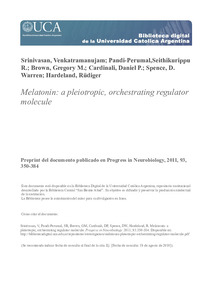Por favor, use este identificador para citar o enlazar este ítem:
https://repositorio.uca.edu.ar/handle/123456789/1653| Título: | Melatonin : a pleiotropic, orchestrating regulator molecule | Autor: | Srinivasan, Venkataramanujan Pandi Perumal, Seithikurippu R. Brown, Gregory M. Cardinali, Daniel Pedro Spence, David Warren Hardeland, Rüdiger |
Palabras clave: | MELATONINA; SUEÑO; ENVEJECIMIENTO; DIABETES; MITOCONDRIOS; RITMO CIRCADIANO | Fecha de publicación: | 2011 | Editorial: | Elsevier | Cita: | Srinivasan, V., et al. Melatonin : a pleiotropic, orchestrating regulator molecule [en línea]. Preprint de artículo publicado en Progress in Neurobiology. 2011, 93. doi:10.1016/j.pneurobio.2010.12.004. Disponible en: https://repositorio.uca.edu.ar/handle/123456789/1653 | Resumen: | Abstract: Melatonin, the neurohormone of the pineal gland, is also produced by various other tissues and cells. It acts via G protein-coupled receptors expressed in various areas of the central nervous system and in peripheral tissues. Parallel signaling mechanisms lead to cell-specific control and recruitment of downstream factors, including various kinases, transcription factors and ion channels. Additional actions via nuclear receptors and other binding sites are likely. By virtue of high receptor density in the circadian pacemaker, melatonin is involved in the phasing of circadian rhythms and sleep promotion. Additionally, it exerts effects on peripheral oscillators, including phase coupling of parallel cellular clocks based on alternate use of core oscillator proteins. Direct central and peripheral actions concern the up- or downregulation of various proteins, among which inducible and neuronal NO synthases seem to be of particular importance for antagonizing inflammation and excitotoxicity. The methoxyindole is also synthesized in several peripheral tissues, so that the total content of tissue melatonin exceeds by far the amounts in the circulation. Emerging fields in melatonin research concern receptor polymorphism in relation to various diseases, the control of sleep, the metabolic syndrome, weight control, diabetes type 2 and insulin resistance, and mitochondrial effects. Control of electron flux, prevention of bottlenecks in the respiratory chain and electron leakage contribute to the avoidance of damage by free radicals and seem to be important in neuroprotection, inflammatory diseases and, presumably, aging. Newly discovered influences on sirtuins and downstream factors indicate that melatonin has a role in mitochondrial biogenesis. | URI: | https://repositorio.uca.edu.ar/handle/123456789/1653 | ISSN: | 0301-0082 | Disciplina: | MEDICINA | DOI: | 10.1016/j.pneurobio.2010.12.004 | Derechos: | Acceso Abierto | Fuente: | Progress in Neurobiology. 2011, 93 |
| Aparece en las colecciones: | Artículos |
Ficheros en este ítem:
| Fichero | Descripción | Tamaño | Formato | |
|---|---|---|---|---|
| melatonin-pleiotropic-orchestrating-regulator-molecule.pdf | 569,36 kB | Adobe PDF |  Visualizar/Abrir |
Visualizaciones de página(s)
269
comprobado en 30-abr-2024
Descarga(s)
1.301
comprobado en 30-abr-2024
Google ScholarTM
Ver en Google Scholar
Altmetric
Altmetric
Este ítem está sujeto a una Licencia Creative Commons

